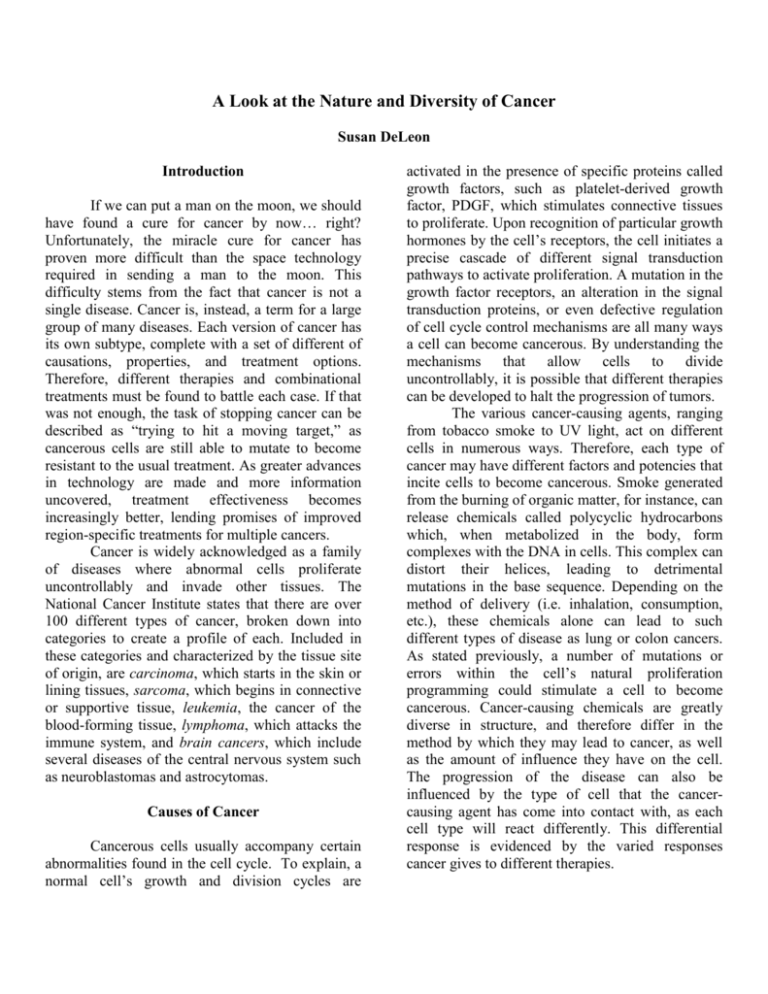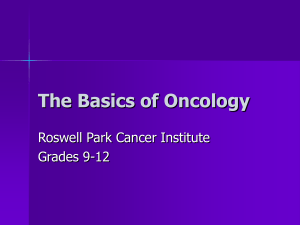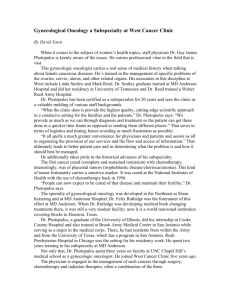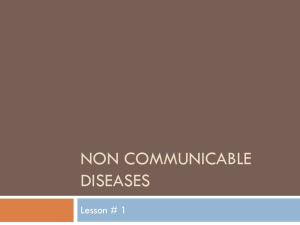Susan DeLeon - Error: Browser Problem
advertisement

A Look at the Nature and Diversity of Cancer Susan DeLeon Introduction If we can put a man on the moon, we should have found a cure for cancer by now… right? Unfortunately, the miracle cure for cancer has proven more difficult than the space technology required in sending a man to the moon. This difficulty stems from the fact that cancer is not a single disease. Cancer is, instead, a term for a large group of many diseases. Each version of cancer has its own subtype, complete with a set of different of causations, properties, and treatment options. Therefore, different therapies and combinational treatments must be found to battle each case. If that was not enough, the task of stopping cancer can be described as “trying to hit a moving target,” as cancerous cells are still able to mutate to become resistant to the usual treatment. As greater advances in technology are made and more information uncovered, treatment effectiveness becomes increasingly better, lending promises of improved region-specific treatments for multiple cancers. Cancer is widely acknowledged as a family of diseases where abnormal cells proliferate uncontrollably and invade other tissues. The National Cancer Institute states that there are over 100 different types of cancer, broken down into categories to create a profile of each. Included in these categories and characterized by the tissue site of origin, are carcinoma, which starts in the skin or lining tissues, sarcoma, which begins in connective or supportive tissue, leukemia, the cancer of the blood-forming tissue, lymphoma, which attacks the immune system, and brain cancers, which include several diseases of the central nervous system such as neuroblastomas and astrocytomas. Causes of Cancer Cancerous cells usually accompany certain abnormalities found in the cell cycle. To explain, a normal cell’s growth and division cycles are activated in the presence of specific proteins called growth factors, such as platelet-derived growth factor, PDGF, which stimulates connective tissues to proliferate. Upon recognition of particular growth hormones by the cell’s receptors, the cell initiates a precise cascade of different signal transduction pathways to activate proliferation. A mutation in the growth factor receptors, an alteration in the signal transduction proteins, or even defective regulation of cell cycle control mechanisms are all many ways a cell can become cancerous. By understanding the mechanisms that allow cells to divide uncontrollably, it is possible that different therapies can be developed to halt the progression of tumors. The various cancer-causing agents, ranging from tobacco smoke to UV light, act on different cells in numerous ways. Therefore, each type of cancer may have different factors and potencies that incite cells to become cancerous. Smoke generated from the burning of organic matter, for instance, can release chemicals called polycyclic hydrocarbons which, when metabolized in the body, form complexes with the DNA in cells. This complex can distort their helices, leading to detrimental mutations in the base sequence. Depending on the method of delivery (i.e. inhalation, consumption, etc.), these chemicals alone can lead to such different types of disease as lung or colon cancers. As stated previously, a number of mutations or errors within the cell’s natural proliferation programming could stimulate a cell to become cancerous. Cancer-causing chemicals are greatly diverse in structure, and therefore differ in the method by which they may lead to cancer, as well as the amount of influence they have on the cell. The progression of the disease can also be influenced by the type of cell that the cancercausing agent has come into contact with, as each cell type will react differently. This differential response is evidenced by the varied responses cancer gives to different therapies. Current Treatment Options Many people are already familiar with known cancer treatments such as surgery, radiation, and chemotherapy. These therapies tend to be the first line of defense, as the treatments that have been around the longest. However, each therapy has its drawbacks, depending on the location of the tumor, type of cancer, and its stage. Often, a combination of these treatments must be used. For instance, surgery is used to remove cancer in most patients today. However, once a tumor has metastasized, or spread to other organs, surgery alone is not enough. Roughly half of all internal cancers, unfortunately, are unable to be detected until the cells have gained the ability to metastasize and infect other regions. Most of the current treatment options available act as a shotgun approach, messy and imprecise. The effectiveness of these methods still depends heavily on the stage of cancer being treated. Radiation is a treatment that can potentially work in two different ways: it can initiate damage to a cancerous cell’s DNA that could trigger apoptosis, programmed cell death, via the p53 protein signaling pathway, or it can cause chromosomal damage so severe that a dividing cancer cell will undergo mitotic death. Radiation treatment, however, would not have any affect on the p53 pathway in a cell whose p53 gene has been mutated. Radiation is also just as effective at killing harmless, non-cancerous tissue, a complication which could cause serious damage in the patient. Performing radiation in areas such as the bone marrow, where vital blood cells are produced, or gastrointestinal area could prove to have severe side-effects. These two sites contain a large number of rapidly dividing cells, and so complications ranging from nausea to immune deficiencies can occur when these areas are subject to radiation. Radiation therapy is used more often in some types of cancers than in others because certain cancers are actually more sensitive to radiation than others. Hodgkin’s disease, a type of lymphoma, as well as neuroblastoma and seminoma are very responsive to the treatment, whereas sarcomas, kidney cancer, and pancreatic cancer do not respond as readily and are more difficult to control on radiation alone, due to inherent tissue sensitivity. Some cancers such as melanoma are even relatively resistant to radiation therapy. Chemotherapy is one of the more successful treatments for destroying certain forms of early leukemia. When used in conjunction with the other two preceding forms of treatment, though, it may be used to treat many different cancers. Chemotherapy can come in many different forms. Some, called antimetabolites, have the ability to pose as substances involved in metabolic pathways whereby they can inhibit the metabolism of cancerous cells. Some therapeutic drugs, including naturally occurring antibiotics, may act as mutagens on the cancerous cells’ DNA and trigger cell damage. The problem with chemotherapy, once again, is that it cannot differentiate between the normal and abnormal cells. The loss of hair that patients experience while undergoing chemotherapy is a result of the drug’s effect on normal cells of the hair follicle. A diverse range of chemicals are used based upon the correlation to results seen in various cancer diseases. Due to differing sensitivities to treatments within many tissues, as well as the constant evolution of cancer cells, each specific type of cancer can greatly affect the treatment options available. The Potential for Tailored Therapies The current treatments have come far in recent years, but they still have potential for improvement. Between drug toxicity to normal cells and mutations within cancers that sometimes render chemotherapy ineffective, new solutions are constantly sought. Some tumors may develop resistance to several drugs at once by forming transport proteins that can pump the medication back into the extracellular environment. These protein pumps facilitate mutidrug resistance via their ability to export a wide range of molecules, including chemotherapy drugs. This reverse transport can therefore negate the effects of a chemotherapy drug before it has a chance to work. Like a child who spits out bad-tasting medicine before it gets into his system, the cancer cells can therefore reduce the beneficial effects of the drug. Other cancers may have a mutation in the apoptotic pathways, which would make a drug that uses this cell death pathway useless. Thus, these problems with different variants of cancer have driven researchers to turn to emerging treatments such as new types of immunotherapy and molecular targeting. Better selectivity in cancer treatment would produce more tailored therapies, which would in turn make more promising treatments for patients. Recently, treatments have been implemented in the form of a vaccine to prevent certain types of cancer, namely cancers resulting from HPV (human papillomavirus). Such a treatment is a form of immunotherapy, which involves the stimulation of the body’s own immune system to fight against or prevent the cancer. This treatment is under constant investigation, as it may be possible that an individual may have the potential cure for his or her own cancer available, with only the need for artificial selectivity for the cancer-fighting properties for lymphocytes. Molecular and genetic testing of the individual patients’ cancer cells is proving to be extremely promising as well. Analyzing the gene expression patterns and presence of certain mutations within cancer specimens would provide much information about the best route for appropriate cancer treatment. A more specific, tailored treatment would in effect maximize the benefits for the patient and decrease the risks and side effects. In recent years, analyses of lung cancer tumors have shown that many contain a mutant growth factor (EFG) receptor. Genetic testing of patients with lung cancer revealed that 10% of them responded extraordinarily well to an inhibitor to the EFG receptor. Many other molecular-targeting drugs are being investigated, though few seem to hold consistent results between patients. This testing, however, could be the key to tailoring the best cure for each cancer. cancers are discovered at too late a stage to hold a good chance of being overcome via these treatment strategies, and all that may occur, is a delay in severity. Nevertheless, research is now beginning to comprehend the different profiles of tumors based upon their makeup, progression, and tissue of origin, in order to truly bring the development of cancer to a halt. The ongoing evolution of the cancer cells, such as their ability to metastasize to another region, or their resistance to effective drugs, yields difficulties in finding a treatment that can possibly be used against all aspects of every profile. The development of a “magic bullet” treatment, which would seek and destroy only the cancerous cells in the body, remains a formidable challenge. Yet, newer approaches designed to selectively target the sources of the disease are beginning to demonstrate much potential for not one, but a series of different cures in the future. References Greenblatt, Rebecca J. (2005) Human papillomaviruses: Diseases, diagnosis, and a possible vaccine. Clinical Microbiology Newsletter 18: 139-145 Kleinsmith, Lewis J. Principles of Cancer Biology. San Francisco: Benjamin Cummings; 2006 National Cancer Institute [Internet]. c2007 [cited 2007 Dec 27]. Available from: http://www.cancer.gov /. Concluding Remarks Due to the vast complexities of cancer, the conventional treatments most widely used are not designed with enough specificity to target only cancerous cells and leave non-cancerous cells unharmed. These treatments, however, continue to be delivered since the damage to the normal cells is outweighed by the benefits of treating the detrimental cancer cells. Unfortunately, many Susan DeLeon, a sophomore from San Antonio, Texas, is currently pursuing a major in microbiology and a minor in Russian. She has recently been named a McNair Scholar and recipient of the Grantland and Louise Rice Academic Scholarship. At any given moment, she can be found in the Caldwell lab, performing experiments regarding the genetic causes behind Parkinson’s disease.




